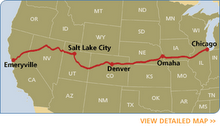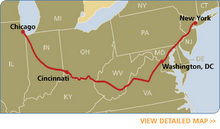I apologize for the delay. Here's Part Two of the Chicago Blues Shuffle and you might need this, see link below...(What a Difference a Day Makes – Dinah Washington) The next morning I woke, ready to get started. I figured if I timed everything correctly, I could hit two museums – The Pullman Porter Museum and the DuSable Museum of African American History. I knew that I have quite a way to travel and since I had planned on using public transportation of some kind, I just had to organize everything well.
One of my contacts was working and we weren’t meeting until evening but she gave me a general idea of where to begin. I went straight to the concierge, who was helpful, providing me with a map, directions to the nearest Metra station and informing me I had less than fifteen minutes to make my train.
It’s still a beautiful weather, cooler than the Chicago I anticipated. I wore a sleeveless dress and some sandals. I thought about purchasing a cheap jacket or sweater at some nearby store but I didn’t have time to stop for breakfast if I was going to catch the train. When I get to the station, which I found easily enough, I discovered that finding my way is a little more challenging; platforms and in-bound and out-bound trains are not identified. I spoke with the only agent I would see the entire day and she directed to the right platform and instructed me to board the third train that came by. This was a little different than what I had told by the concierge but I didn’t think anything of it. (
Hobo, Don’t you Ride this Train- Louis Armstrong) On the Metra, conductor comes by and punches holes in your ticket which I thought was quaint and old-fashioned, like something I had once seen in a black and white movie. The ride, itself, took me away from downtown and I saw the parts of Chicago I had also heard about – crumbling, abandoned houses with boarded windows and vacant lots -- evidence that if there was an economic recovery, it hasn’t reached everywhere.
The train sped past several stops, which didn’t disturb me until I saw my stop (111th/Pullman) fly by. Before I could protest, we were stopping at the next station, some five blocks away from Pullman, where the concierge directed me to go. But it’s five blocks, no big deal, right?
(Traveling Light- Billie Holiday) I figured that the street I was looking for probably crossed the street I was on. I’d walk up and cross over. Now the map I had wasn’t detailed enough to provide the streets of the neighborhood I was in. It indicated the district but little else. The concierge had told me that I’d need to get specific directions from the agent but there was no agent at the station. So I asked a young girl walking by me on the street to point me in the direction of Maryland Street.
She told me it would be easier to reach by bus but I had no change or small bills, so I decided to walk until I found a store; besides, I like walking.
(Strut That Thing – Cripple Clarence Lofton) I liked the neighborhood, which reminded me of the houses that surrounded the cul-de-sac where my grandparents lived in St. Louis. Small framed houses of brick with little porches, where people sit and stare at folks walking by (in this case, me) fronted by crumbling, gutted sidewalks. I’m not in Bronzeville, where I understand most of the Chicago Porters lived. I’m just outside of Pullman, where George Pullman created housing for his employees who built the Pullman cars. This housing was intended for his white employees only. The black porters, who epitomized the Pullman standard of luxury and glamour, had to make do elsewhere.
(He’s a Son of the South – Louis Armstrong)Of course, that was then and this is now. Black folks were everywhere. Few spoke to me. Some clearly wondered who I was and what I was doing but said very little.
(Well, that isn’t strictly true. A man missing his front teeth and wearing a Black History Month t-shirt asked, “What your name is?” Later, a van, pulled alongside me, with one young man behind the wheel and another hiding behind a curtain in the back, The man behind the curtain told me, “I shore had some pretty feet.” A compliment, I might add I was kind of grateful for since I had done my own pedicure.)
I had been walking for several blocks and still hadn’t seen Maryland. The major intersection I found was Michigan Avenue and that was a slight tickling in the back of my mind which I ignored. I assumed that the streets named after states had to be close to one another, so I just kept walking. After all, both the concierge and the young woman who gave me directions told me I’d have to walk a little ways to get there.
(Some Day You’ll Be Sorry – Louis Armstrong) But, of course, the state named streets disappeared and I’m suddenly wondering how a sister can get lost going in the straight line.
Non- sequitar -- If that ain’t a metaphor for life, I don’t know what is. Sigh, subject for another day.I have to admit that I’m a little fascinated and awed. Somewhere along the way, I pass
Alex Haley School and I feel a little bolstered, as if the sighting of the great writer is a sign I’m on the right track. But by this time, I’m passing the third major intersection and there are no more streets named after states, presidents, colleges or major bodies of water. I’m lost. I’m hungry. My feet hurt. While it isn’t the oppressively humid Chicago I’d heard about, it’s still hot. I’d crossing over Halsted when I finally ask someone where Maryland is. Never heard of it.
Never heard of it? Ain’t this YOUR town? Don’t you live here?I kept these hostile thoughts to myself and ask the next two people I walked by the same with the same results. To avoid seizure, I compose myself and remember something my dad once told me about insanity – doing the same thing over and over again and expecting a different result.
Non-sequitar – I suppose that also is a metaphor for life. SighSo I decided to backtrack, go back to Halstead and walk over to 111th Street and maybe by walking back down 111th, I’ll find Maryland. It was only four blocks and I didn’t come all this quit now. By then, I’ve been out walking almost an hour. I skipped breakfast and my patience decreased at rate greater than the rate my hunger increased. Why didn’t I stop and get some food? Because while I may not be able to understand directions, I do understand myself. The instance, my butt hit a chair, I wasn’t getting up again. Just not going to happen
.
When I finally get to 111th Street, I no longer trust myself, train attendants, concierges or strangers on the street. I decided I needed help. I call information to get the number to the museum (yeah, remember I was trying to find the museum). Soon, I’m connected and I hear the following message: Thank you for calling the A. Phillip Randolph Pullman Porter Museum. The museum will closed until July 26th. Then that nice telephone lady says that the mailbox has been closed.
(I Been Mistreated and I Don’t Like it – Bessie Smith)(to be continued)




























